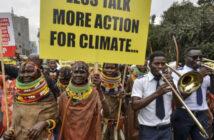The Prime Minister of Australia, Malcolm Turnbull yesterday declares open the Liquefied Natural Gas Conference, LNG 18 in Perth, Australia. The 4 days event is the gathering for all the major players in LNG industry in the world. Below is the full transcript of the opening and welcoming address of the Australian Prime Minister.
Well thank you very much Grant, and Jerome Ferrier the LNG 18 Steering Committee Chair, our host the Premier of Western Australian, Colin Barnett with whom we were up at Barrow Island inspecting the great Gorgon project today. Can I also thank you Simon Forrest for your welcome to the land of the Noongar people, reminding us of their enduring connection to the land and waters, and all of us thank you for that, we honour you, and we pay my respects to your elders past and present. And we do so conscious of the millennia, the tens and tens of thousands of years over which Aboriginal people have walked upon and cared for this country.
As I mentioned, we were just at Barrow Island and of course Karratha before that, and there you find those extraordinary rock carvings of the Borough Peninsula. Extraordinary work, some of the oldest works of art in the world. Some of the oldest depictions of people and animals, animals long extinct, imagery, allegory, a remarkable place. And there side by side with the technology of the 21st century, and the energy of the 21stcentury. I want to extend a warm welcome to all our international visitors, and to those who have travelled from around Australia.
I am delighted to open this, the 18th International Conference and Exhibition on Liquefied Natural Gas. This year’s conference theme ‘Redrawing the Global Map of Gas’ comes as we are witnessing huge shifts in the supply and demand for key resources, including LNG.
Prices for our key commodities exports including LNG have fallen materially as new supply has come on stream both here and elsewhere. But volumes have grown as you know enormously. Global growth has slowed somewhat as China’s economy transitions and investment as a share of GDP declines at the expense of stronger and more sustainable household consumption.
Our terms of trade – the ratio of our export to import prices – are down 34 per cent since their peak. Resource construction activity has fallen from an unprecedented level of nearly 8 per cent of GDP, to around half that.
Now this was always going to happen – the resources construction boom has peaked for the time being and has subsided for time being because the new mines and LNG trains have been or are being completed – but the production phase will continue as long the world needs energy and steel. I think we all agree that will be a very long time.
To put this in perspective, we are now most of the way through the largest terms of trade shock in our history. The good news is that we will not only survive this cyclical shock – the largest in our history – but also we are emerging stronger, much stronger, out on the other side. Last year 3 per cent, real GDP growth 300,000 jobs created the highest number since 2006 before the GFC.
Now rather than abandoning mines or plugging wells, you have adapted to lower prices by reducing costs, pushing the frontiers of innovation and increasing market share. And one of the greatest examples of innovation, resilience and expansion is LNG.
This morning we visited the Gorgon Project. I’ve had a personal association with that since I gave its final environmental approval when I was Minister in John Howard’s Government back in 2007 so it was wonderful to see it there built. The special engineering challenges of Gorgon were driven by the need to minimise the environmental footprint on this Class A Nature reserve. Cared for so carefully for so long by Chevron of course under the guidance of the legendary Harry Butler.
The engineers managed to compress this project to just over 300 hectares, a tiny footprint by industry standards, ensuring the least possible disturbance to the flora and fauna. And they also developed the world’s largest greenhouse gas mitigation initiative: separating carbon dioxide from the gas and injecting it into a saline formation up to 2km underground. The largest carbon capture and storage project. A light step on the landscape, a massive contribution to global energy needs.
And then, of course off the coast of Western Australia, Shell’s Prelude Floating LNG project will be the largest offshore facility ever built. It will be half a kilometre long, weigh six times as much as the largest aircraft carrier and contain five times more steel than the Sydney Harbour Bridge.
These innovative feats of engineering, remarkable, together with several others that are soon to come on stream, will make Australia the world’s leading exporter of LNG. Every Western Australian knows how oil, gas and resource companies have made enormous contributions to this nation.
During the decade of rising prices, they delivered the largest investment boom Australia has ever seen. At the peak of its construction phase LNG alone created more than 100,000 jobs across Australia. Now in the production phase the sector is providing thousands of long term jobs. It has been a remarkable contribution to Australia through the export of this fuel to the whole world.
Now our Government understands that Australia’s openness to foreign investment has been critical to unlocking our natural resource wealth. Record investment of over $400 billion is now translating into increased production capacity and the real resources and energy capital stock is four times higher than it was before the boom. It has enabled Australia to cement its status as a world leader in resource development and to build influence throughout the region.
In the same way that firms operate big resource projects here under an implicit social licence, the Government also has important obligations, like preserving and expanding the system of open markets. We must continue to ensure appropriate regulatory settings are in place, so that the huge amounts of newly installed capital I spoke of earlier are utilized as efficiently as possible.
To fulfil our side of the deal, we must do more than simply welcome foreign investment. That’s why we are reducing regulation; speeding up the process of environmental approvals; making the workforce more efficient and reducing production costs through skills and migration initiatives.
We will continue to ensure that our taxation system encourages investment, entrepreneurship and job creation. And at the same time we will continue to ensure that every business – large or small – pays their fair share of tax in accordance with the law.
We are aggressively expanding market opportunities through our free-trade agreements with China, Japan, and Korea. Important also is the Trans Pacific Partnership, the trade agreement we helped negotiate with 11 other nations across the Pacific.
The TPP takes aim at 21st century trade barriers that many of us perhaps didn’t know existed until recently, such as “data protectionism”, which is becoming a concern for our resource companies as they analyse terabytes of data from automated operations around the world.
We know we cannot be complacent. We know we have to do more to provide a secure and promising and attractive investment environment. One of the important levers to secure our nation’s prosperity and economic security is to re-establish the Australian Building and Construction Commission.
That’s why we are bringing the parliament back next week to deal with the ABCC and an associated Registered Organisation Bill. An efficient construction industry is absolutely vital to our transition to the new economy.
The additional costs of construction in Australia due to industrial disputes and often standover tactics by militant unions are a serious handbrake on economic growth. And we intend to deal with them and that is why Parliament is returning on the 18th of April.
Our economic plan will ensure that Australia is: More productive, more competitive, more innovative, and that our kids are learning the digital skills of the 21st century. Our cities are more liveable and more efficient. Our tax system is sustainable and encourages investment and jobs, and we remain and become even more so, the best place in the world to live, to invest, to realize your dreams.
Since 1989, when the Woodside-operated North West Shelf Project delivered its first LNG cargo, the LNG industry has witnessed phenomenal growth. Its been tied to the tremendous economic expansion that we’ve seen right here in our region. And these trends will continue.
By 2021, there could be more than two billion people in middle class households in Asia who aspire to not only the best in food, wine, travel and education but also the energy to power their new businesses and homes.
Later this week, I’ll be exploring new opportunities in China where gas consumption is expected to more than double by 2030. More broadly, Australia will provide about 40% of both China and Japan’s LNG imports, and 25% of Korea’s by 2020.
And our overall LNG exports will treble to around 75 million tonnes by 2020—making it our second most valuable export after iron ore. Yes, the sector has had some pressure in terms of prices but Australia looks to the future with enormous optimism.
Gas, which can produce 50 per cent less emissions than a typical coal-fired power plant, has a pivotal role in delivering energy with lower carbon emissions, making it a key contributor to global carbon abatement. It is also critical fuel stock for peak energy demand.
We need to support the transition to renewables by providing peaking power and fill the gap from intermittent renewables when the sun is not shining or the wind is not blowing. It is all part of our broader aim to ensure our energy security into the future. Gas is a critical part of the environmental agenda for the future to a cleaner, greener planet.
I talked about the extraordinary projects I’ve seen in the north of WA but the story is a similar one across the whole north of our great nation. In Queensland we are seeing a world-first with LNG projects using coal seam gas as their main feedstock. In just a decade, we have gone from being a beginner to being a world leader in CSG knowledge and technology, with three LNG plants now operating on Curtis Island.
In the Northern Territory, Japan’s INPEX is on track to deliver Darwin’s second LNG project after ConocoPhillips’ Wickham Point came on stream in 2006. INPEX’s Ichthys LNG Project is effectively three mega-projects rolled into one, involving some of the largest offshore facilities in the industry, a state-of-the-art onshore processing facility and an 890 km pipeline for its life of 40 years.
The resources and energy sectors have been, and will remain, at the very heart of our economy and our future. Now as we noted, the industry is currently dealing with challenges caused by lower prices. But you respond by innovating, being more efficient and increasing your market share. And we, like you, know that we cannot afford to be complacent in capturing future resource investment opportunities.
My government will continue to make Australia an attractive environment for investment, whilst ensuring the benefits are shared with communities and the environment is protected. The opportunities have never been greater for every Australian – living, working and investing in a world that is faster, more competitive, more technologically sophisticated than ever before.
I wish you all the very best for a successful LNG 18.



